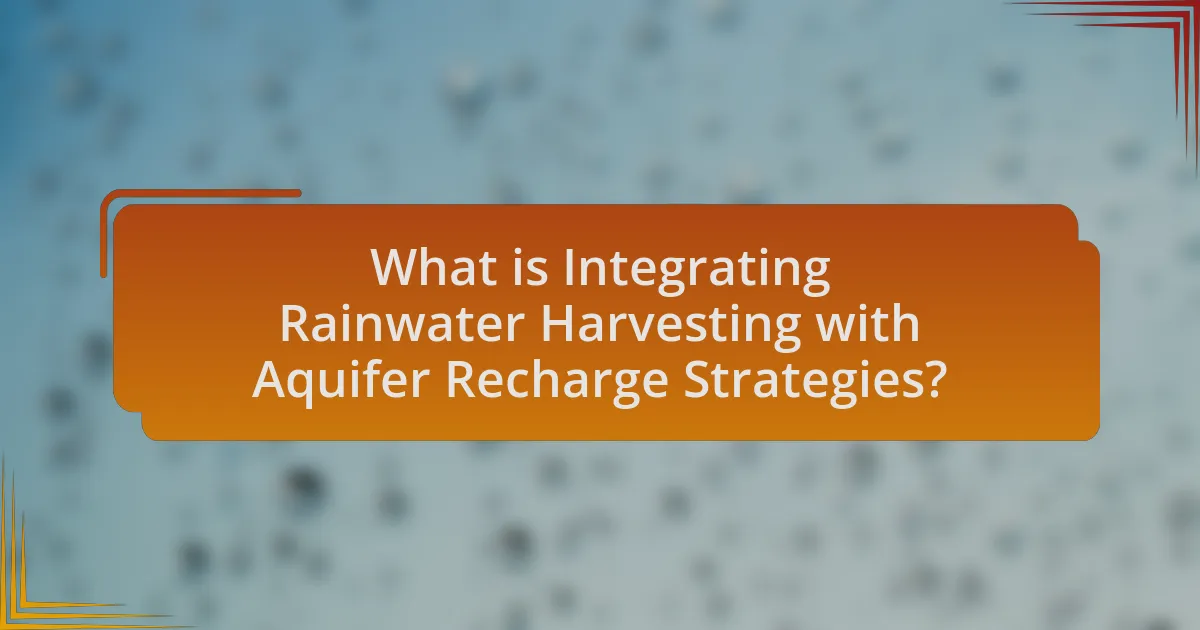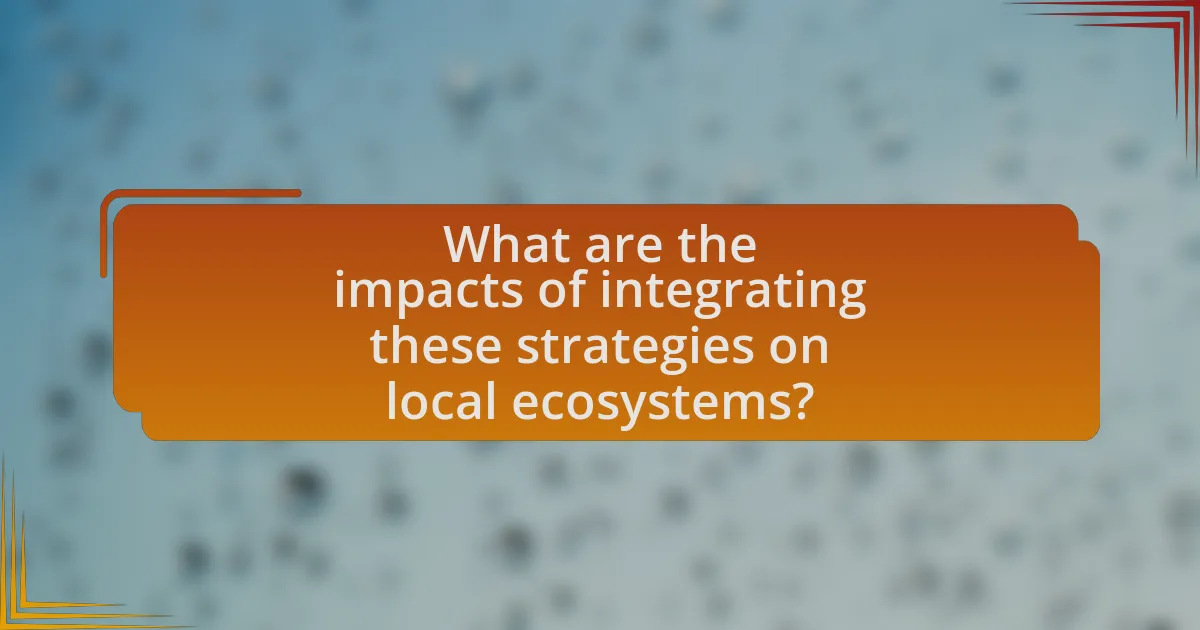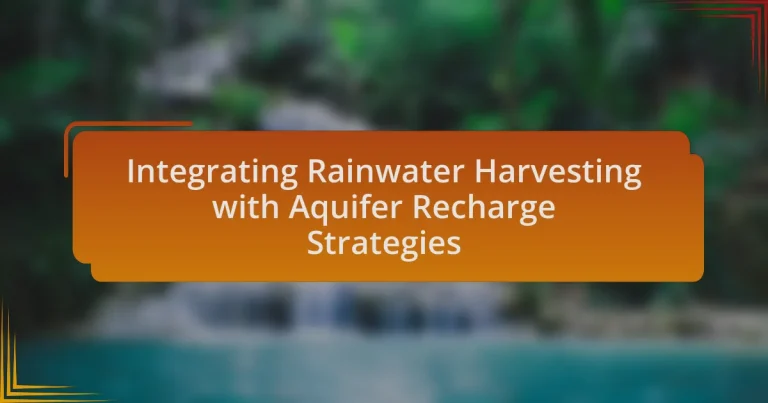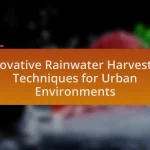Integrating rainwater harvesting with aquifer recharge strategies is a systematic approach aimed at enhancing groundwater levels through the collection and storage of rainwater. This integration not only reduces surface runoff but also significantly improves water availability, particularly in arid regions, by replenishing aquifers. Key principles include effective rainwater collection, proper filtration, and the design of infrastructure that considers local hydrology. The article discusses the environmental benefits, challenges, and best practices for successful implementation, emphasizing the importance of community engagement and technological advancements in optimizing these water management strategies. Additionally, it highlights the economic implications and funding opportunities available for communities seeking to adopt these sustainable practices.
What is Integrating Rainwater Harvesting with Aquifer Recharge Strategies?

Integrating rainwater harvesting with aquifer recharge strategies involves the systematic collection and storage of rainwater to enhance groundwater levels through infiltration. This approach not only mitigates surface runoff but also replenishes aquifers, thereby improving water availability during dry periods. Studies indicate that effective integration can lead to significant increases in groundwater recharge rates, with some regions reporting enhancements of up to 30% in aquifer levels due to such practices.
How do rainwater harvesting and aquifer recharge work together?
Rainwater harvesting and aquifer recharge work together by capturing and directing rainwater into the ground to replenish groundwater supplies. Rainwater harvesting systems collect precipitation from surfaces like roofs, which is then stored and can be used for various purposes. When this harvested rainwater is intentionally infiltrated into the soil, it enhances aquifer recharge by increasing the amount of water that percolates down to underground aquifers. Studies show that integrating these two practices can significantly improve water availability, especially in arid regions, by utilizing natural rainfall to sustain groundwater levels, thereby promoting sustainable water management.
What are the key principles of rainwater harvesting?
The key principles of rainwater harvesting include the collection, storage, and utilization of rainwater for various purposes. This process begins with the capture of rainwater from surfaces such as roofs, which is then directed into storage systems like tanks or cisterns. Proper filtration and treatment are essential to ensure the water is safe for use. Additionally, the design of the harvesting system must consider local rainfall patterns and the intended use of the water, whether for irrigation, domestic use, or aquifer recharge. Effective rainwater harvesting can significantly reduce reliance on conventional water sources and enhance groundwater levels, contributing to sustainable water management practices.
What are the fundamental concepts of aquifer recharge?
Aquifer recharge involves the process of replenishing groundwater supplies by allowing water to percolate through the soil and into aquifers. This process is essential for maintaining sustainable water resources, especially in areas facing water scarcity. Key concepts include natural recharge, which occurs through precipitation and surface water infiltration, and artificial recharge, which is facilitated by human activities such as rainwater harvesting and managed aquifer recharge systems. Studies indicate that effective aquifer recharge can enhance water availability, improve water quality, and support ecosystem health, making it a critical component of integrated water resource management.
Why is integrating these strategies important?
Integrating rainwater harvesting with aquifer recharge strategies is important because it enhances water sustainability and resource management. This integration allows for the efficient use of rainwater, reducing surface runoff and promoting groundwater replenishment. Studies indicate that combining these strategies can increase groundwater levels by up to 30%, thereby improving water availability during dry periods and mitigating the impacts of drought. Furthermore, this approach can lead to improved water quality by filtering rainwater through natural aquifer systems, which is essential for maintaining ecosystem health and supporting agricultural practices.
What environmental benefits arise from this integration?
Integrating rainwater harvesting with aquifer recharge strategies provides significant environmental benefits, including enhanced groundwater levels and improved water quality. This integration allows for the capture and storage of rainwater, which can replenish aquifers, thereby mitigating the effects of drought and reducing reliance on surface water sources. Studies indicate that effective rainwater harvesting can increase groundwater recharge rates by up to 50%, leading to more sustainable water management practices. Additionally, the filtration process during aquifer recharge can remove pollutants from rainwater, resulting in cleaner groundwater supplies.
How does this integration contribute to water sustainability?
Integrating rainwater harvesting with aquifer recharge strategies significantly enhances water sustainability by increasing the availability of freshwater resources. This integration allows for the collection and storage of rainwater, which can then be directed to recharge aquifers, thereby replenishing groundwater supplies that are essential for drinking water, agriculture, and ecosystem health. Studies indicate that effective rainwater harvesting can reduce surface runoff by up to 90%, leading to improved groundwater levels and reduced flooding. Additionally, this method mitigates the depletion of aquifers, which are critical in areas facing water scarcity, thus promoting long-term water sustainability.
What challenges are faced in integrating these strategies?
Integrating rainwater harvesting with aquifer recharge strategies faces several challenges, primarily related to technical, regulatory, and community engagement issues. Technical challenges include the need for appropriate infrastructure to capture and store rainwater effectively, as well as ensuring that the quality of harvested rainwater meets the standards for aquifer recharge. Regulatory challenges arise from the need to navigate complex water rights and land use regulations, which can vary significantly by region. Community engagement is crucial, as local stakeholders must understand and support the integration of these strategies for successful implementation. Studies have shown that without community buy-in, projects often face resistance, leading to underutilization or failure.
What technical obstacles must be overcome?
Technical obstacles that must be overcome in integrating rainwater harvesting with aquifer recharge strategies include the need for effective water quality management, the design of appropriate infrastructure, and the establishment of regulatory frameworks. Effective water quality management is crucial because rainwater can carry pollutants that may compromise aquifer integrity; studies indicate that untreated rainwater can contain contaminants such as heavy metals and pathogens. The design of appropriate infrastructure is necessary to ensure efficient collection, storage, and distribution of harvested rainwater, which requires advanced engineering solutions to prevent overflow and leakage. Additionally, establishing regulatory frameworks is essential to guide the implementation of these systems, as inconsistent regulations can hinder adoption and create barriers to investment.
How do regulatory frameworks impact integration efforts?
Regulatory frameworks significantly influence integration efforts by establishing guidelines and standards that govern the implementation of rainwater harvesting and aquifer recharge strategies. These frameworks can facilitate or hinder integration by defining permissible practices, ensuring environmental protection, and promoting sustainable resource management. For instance, regulations may require permits for rainwater harvesting systems, which can streamline the process and encourage compliance with best practices. Conversely, overly restrictive regulations can create barriers to implementation, limiting the adoption of innovative techniques. Evidence from various regions shows that effective regulatory frameworks, such as those in California, have led to increased adoption of rainwater harvesting systems, demonstrating a positive correlation between supportive regulations and successful integration efforts.
How can communities implement these strategies effectively?
Communities can implement rainwater harvesting and aquifer recharge strategies effectively by establishing clear guidelines and infrastructure for collection and storage. This involves creating systems for capturing rainwater from rooftops and other surfaces, directing it into storage tanks, and ensuring that the water is filtered and treated appropriately before use.
Additionally, communities should engage in public education campaigns to raise awareness about the benefits of these strategies, which include reducing stormwater runoff and replenishing local aquifers. Research indicates that communities that adopt integrated water management practices can increase their water supply resilience by up to 30%, as demonstrated in case studies from regions like California and Australia.
Furthermore, collaboration with local governments, environmental organizations, and community members is essential to secure funding and resources for implementation. By fostering partnerships, communities can leverage expertise and share best practices, leading to more successful outcomes in integrating rainwater harvesting with aquifer recharge.
What are the best practices for successful integration?
The best practices for successful integration of rainwater harvesting with aquifer recharge strategies include comprehensive planning, stakeholder engagement, and effective monitoring. Comprehensive planning ensures that both systems are designed to complement each other, optimizing water capture and recharge rates. Stakeholder engagement involves collaboration among local communities, government agencies, and environmental organizations to align goals and resources. Effective monitoring utilizes data collection and analysis to assess the performance of the integrated systems, allowing for adjustments and improvements over time. These practices are supported by case studies, such as the successful implementation in the city of Bangalore, India, where integrated approaches have led to increased groundwater levels and improved water quality.
What role do community engagement and education play?
Community engagement and education play a crucial role in the successful implementation of rainwater harvesting and aquifer recharge strategies. Engaging the community fosters local ownership and encourages participation, which is essential for the sustainability of these initiatives. Education equips individuals with the knowledge and skills necessary to effectively manage water resources, understand the benefits of rainwater harvesting, and adopt best practices. Research indicates that projects involving community participation have a higher success rate; for instance, a study by the International Water Management Institute found that community-led initiatives in water management significantly improved water conservation efforts and increased local awareness of sustainable practices.
How can technology enhance the integration process?
Technology can enhance the integration process of rainwater harvesting with aquifer recharge strategies by utilizing advanced data analytics and monitoring systems. These technologies enable real-time assessment of water quality and quantity, ensuring optimal management of resources. For instance, Geographic Information Systems (GIS) can map suitable locations for rainwater harvesting systems, while sensors can monitor rainfall and groundwater levels, providing critical data for decision-making. Studies have shown that integrating these technologies can increase the efficiency of water use by up to 30%, demonstrating their effectiveness in improving the integration process.
What are the specific methods for rainwater harvesting?

The specific methods for rainwater harvesting include rooftop collection, surface runoff harvesting, and rain gardens. Rooftop collection involves directing rainwater from roofs into storage tanks, which can be used for irrigation or household purposes. Surface runoff harvesting captures rainwater from paved areas or land surfaces, channeling it into storage systems or infiltration basins. Rain gardens are designed to absorb rainwater runoff from impervious surfaces, allowing it to percolate into the ground, thus recharging aquifers. These methods are effective in managing water resources and enhancing groundwater levels.
How can different systems be designed for effective rainwater collection?
Different systems for effective rainwater collection can be designed by incorporating various components such as catchment surfaces, storage tanks, filtration systems, and distribution networks. For instance, sloped roofs can serve as efficient catchment areas, directing rainwater into gutters that lead to storage tanks. These tanks should be constructed from materials that prevent contamination and should include filtration systems to remove debris and pollutants. Additionally, integrating permeable surfaces in urban areas can enhance groundwater recharge, allowing collected rainwater to infiltrate into aquifers. Research indicates that systems designed with dual purposes, such as rainwater harvesting and aquifer recharge, can significantly improve water availability and sustainability in regions facing water scarcity.
What types of rainwater harvesting systems are most effective?
The most effective types of rainwater harvesting systems include rooftop collection systems, surface runoff systems, and underground storage systems. Rooftop collection systems capture rainwater from building roofs, which can yield significant volumes of water; studies indicate that they can collect up to 80% of annual rainfall in urban areas. Surface runoff systems utilize natural land contours to direct rainwater into storage areas, effectively managing stormwater and reducing erosion. Underground storage systems, such as cisterns, provide a means to store harvested rainwater for later use, ensuring water availability during dry periods. These systems are validated by various studies showing their efficiency in water conservation and aquifer recharge, making them integral to sustainable water management practices.
How do maintenance practices affect system efficiency?
Maintenance practices significantly enhance system efficiency by ensuring optimal performance and longevity of components involved in rainwater harvesting and aquifer recharge systems. Regular maintenance, such as cleaning filters and inspecting storage tanks, prevents blockages and contamination, which can lead to reduced water quality and system failures. For instance, a study by the Water Research Foundation found that systems with routine maintenance had a 30% higher efficiency in water collection compared to those that were neglected. This demonstrates that proactive maintenance not only sustains operational efficiency but also maximizes the effectiveness of water resource management strategies.
What are the key considerations for site selection?
Key considerations for site selection in integrating rainwater harvesting with aquifer recharge strategies include hydrological characteristics, land use, soil permeability, and proximity to water sources. Hydrological characteristics, such as rainfall patterns and surface runoff, determine the effectiveness of rainwater harvesting systems. Land use impacts the availability of space and potential contamination risks, while soil permeability affects the infiltration rates necessary for aquifer recharge. Proximity to existing water sources ensures that harvested rainwater can be efficiently directed to recharge areas, enhancing the overall sustainability of the water management system.
How does topography influence rainwater harvesting?
Topography significantly influences rainwater harvesting by determining the flow and accumulation of water in a given area. Variations in elevation, slope, and landform shape the movement of rainwater, affecting how much can be captured and stored. For instance, areas with steep slopes may lead to rapid runoff, reducing the amount of water that can be harvested, while flat or gently sloping terrains facilitate water retention and collection. Additionally, features such as valleys can act as natural catchment areas, enhancing the efficiency of rainwater harvesting systems. Studies have shown that optimizing rainwater harvesting designs according to local topography can increase water capture efficiency by up to 30%, demonstrating the critical role of landscape features in effective water management strategies.
What soil characteristics are important for aquifer recharge?
Soil characteristics important for aquifer recharge include permeability, soil texture, and organic matter content. Permeability determines how easily water can flow through the soil, with sandy soils typically allowing for better recharge compared to clay soils, which have lower permeability. Soil texture influences the distribution of sand, silt, and clay, affecting water retention and movement; loamy soils are often ideal for recharge due to their balanced texture. Additionally, higher organic matter content enhances soil structure and increases water infiltration rates, facilitating aquifer recharge. Studies have shown that soils with these characteristics significantly improve the efficiency of water infiltration and recharge processes.
What are the impacts of integrating these strategies on local ecosystems?

Integrating rainwater harvesting with aquifer recharge strategies positively impacts local ecosystems by enhancing water availability and improving groundwater quality. This integration leads to increased soil moisture, which supports vegetation growth and promotes biodiversity. Additionally, it reduces surface runoff and erosion, thereby protecting local waterways from sedimentation and pollution. Studies have shown that areas implementing these strategies experience a rise in native plant species and a healthier habitat for wildlife, contributing to overall ecosystem resilience.
How does this integration affect groundwater levels?
Integrating rainwater harvesting with aquifer recharge strategies positively affects groundwater levels by increasing the amount of water that infiltrates into aquifers. This integration captures and directs rainwater runoff into recharge areas, enhancing groundwater replenishment. Studies have shown that effective rainwater harvesting can lead to a significant rise in groundwater levels, with some regions experiencing increases of up to 30% in aquifer recharge rates. This process not only helps to restore depleted aquifers but also improves water availability during dry periods, demonstrating the effectiveness of combining these two strategies for sustainable water management.
What changes can be observed in local flora and fauna?
Changes in local flora and fauna include shifts in species composition, increased biodiversity, and alterations in habitat structure. These changes often result from the implementation of rainwater harvesting and aquifer recharge strategies, which enhance water availability and improve soil moisture. For instance, studies have shown that areas utilizing rainwater harvesting techniques experience a resurgence of native plant species, which in turn supports a wider range of animal species. Additionally, the improved water retention in the soil can lead to healthier ecosystems, as evidenced by increased populations of pollinators and other wildlife.
How does it influence water quality in surrounding areas?
Integrating rainwater harvesting with aquifer recharge strategies positively influences water quality in surrounding areas by reducing surface runoff and filtering pollutants. This method captures rainwater, which can then be directed into aquifers, allowing natural filtration through soil layers that removes contaminants such as heavy metals and pathogens. Studies have shown that rainwater harvesting systems can significantly decrease the concentration of nitrates and other harmful substances in groundwater, thereby improving overall water quality. For instance, research conducted by the International Water Management Institute indicates that properly managed rainwater harvesting can lead to a reduction in waterborne diseases and enhance the safety of drinking water supplies.
What are the economic implications of this integration?
The economic implications of integrating rainwater harvesting with aquifer recharge strategies include reduced water supply costs and enhanced water security. By capturing and storing rainwater, communities can decrease their reliance on expensive and often limited external water sources, leading to lower operational costs for water supply systems. Additionally, this integration can improve groundwater levels, which supports agricultural productivity and reduces the need for costly irrigation methods. Studies indicate that regions implementing such strategies can experience significant savings; for instance, a report by the World Bank highlights that rainwater harvesting can reduce urban water supply costs by up to 50%. Furthermore, enhanced aquifer recharge contributes to sustainable water management, which is crucial for long-term economic stability in water-scarce areas.
How can cost savings be achieved through these strategies?
Cost savings can be achieved through integrating rainwater harvesting with aquifer recharge strategies by reducing the need for expensive water supply infrastructure and minimizing water treatment costs. By capturing and utilizing rainwater, communities can decrease their reliance on traditional water sources, which often involve high costs for extraction, transportation, and treatment. For instance, a study by the United Nations Environment Programme indicates that rainwater harvesting can reduce municipal water supply costs by up to 50% in areas with adequate rainfall. Additionally, aquifer recharge enhances groundwater levels, leading to lower pumping costs and improved water quality, further contributing to overall savings.
What funding opportunities exist for communities?
Funding opportunities for communities focused on integrating rainwater harvesting with aquifer recharge strategies include federal grants, state programs, and private foundations. The U.S. Environmental Protection Agency (EPA) offers funding through programs like the Clean Water State Revolving Fund, which supports projects that improve water quality and promote sustainable water management practices. Additionally, the National Oceanic and Atmospheric Administration (NOAA) provides grants for projects that enhance coastal resilience, which can include rainwater harvesting initiatives. Local governments may also have specific funding programs aimed at water conservation and infrastructure improvements. These funding sources are designed to support community efforts in sustainable water management and environmental protection.
What practical steps can be taken to start integrating these strategies?
To start integrating rainwater harvesting with aquifer recharge strategies, implement a systematic approach that includes site assessment, design planning, and community engagement. First, conduct a thorough site assessment to evaluate the local hydrology, soil characteristics, and existing infrastructure, which is essential for determining the feasibility of both rainwater harvesting and aquifer recharge. Next, develop a design plan that incorporates rainwater collection systems, such as cisterns or permeable pavements, alongside recharge wells or trenches, ensuring that the systems are compatible and efficient. Finally, engage the community through educational programs and stakeholder meetings to promote awareness and encourage participation, as community involvement is critical for the success and sustainability of these integrated strategies.


